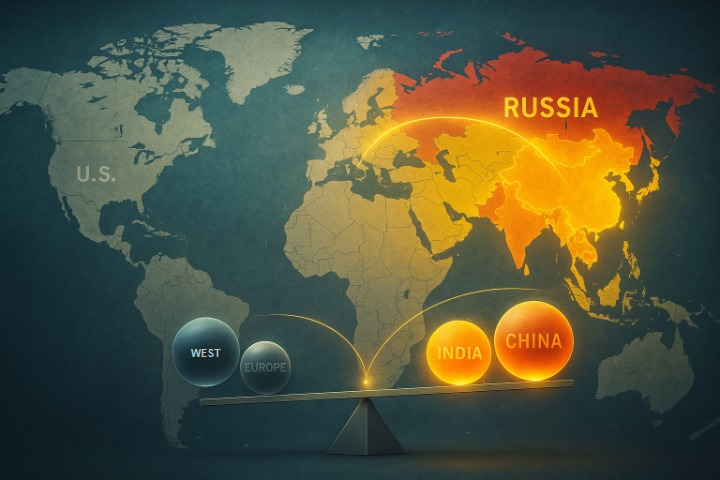
- India, China, and Russia account for nearly 40 per cent of the world’s population and about a third of global GDP (measured in purchasing power parity).
- Divergences suggest that the RIC troika is less a seamless alliance than a coalition of convenience, held together by a shared interest in weakening Western dominance, but divided by competing ambitions.
- The decline of the age of Western monopoly is real, the rules of power are being rewritten before our eyes, and India stands at the centre of these unfolding developments.
The West’s monopoly on global affairs is fading fast. The RIC troika, shaped by trade wars, shifting alliances, and new Eurasian platforms, embodies the rise of multipolarity.
The global balance of power is shifting before our eyes. For decades, the West, anchored by the United States and its allies, has dominated international politics, economics, and security. That dominance is now under challenge, not from a single rival, but from a troika of powers —Russia, India, and China —that are reshaping the rules of global power. This “RIC troika” is not a formal alliance, but its strategic convergence signals a decisive move away from the post–World War II order. Together, these three nations account for nearly 40 per cent of the world’s population and about a third of global GDP (measured in purchasing power parity). India’s young and dynamic workforce, China’s industrial and technological clout, and Russia’s immense natural resources make for a powerful combination. At a time when Europe and North America are ageing and politically fatigued, the RIC bloc embodies the dynamism of the 21st century.
External Shocks and Shifting Alignments
The troika’s momentum has been reinforced by external shocks. Until recently, under the shadow of the 2020 Galwan Valley clashes and a brief but intense conflict with Pakistan, where Islamabad deployed Chinese defence systems, India still treated China as its primary adversary. Yet, external dynamics on the world stage have shifted more rapidly than expected over the past three months. The trade wars unleashed by U.S. President Donald Trump during his second term in the White House, first targeting China, then extending to India with tariffs as high as 50 per cent, forced both Beijing and New Delhi to recalibrate, while Russia was already reeling under Western sanctions from its war in Ukraine. Washington’s protectionist turn pushed China to deepen ties with Moscow, while India, too, began probing limited thaw points with Beijing despite their rivalry. From a realist perspective, these tariff battles show how great-power rivalries produce unexpected alignments of necessity.
Alternatives to Western Clubs
Over the past two decades, institutions such as BRICS and the Shanghai Cooperation Organisation (SCO) have evolved from little-known gatherings into platforms of consequence. These forums are not only about trade or security, but they also represent alternative centres of agenda-setting, outside the orbit of Washington and Brussels. Increasingly, the RIC states use them to press for reforms in global governance, from voting rights in the IMF to permanent seats at the UN Security Council. The recent SCO summit further showcased this shift. From discussions on energy security to digital infrastructure and counterterrorism, the grouping positioned itself as a Eurasian counterweight to Western-led forums like NATO and the G7. While India balanced its rivalry with China against long-standing ties with Russia, its participation signalled the importance of these alternative platforms. For Moscow and Beijing, the summit underscored their argument that the global centre of gravity is drifting eastward.
A Realist Lens
Seen through the prism of realism in international relations, the RIC troika makes sense. Realists view the world as an anarchic system where states pursue power and security above all else. Cooperation, when it happens, is not about shared values but overlapping interests. For Russia, weakened by Western sanctions and isolated after its war in Ukraine, leaning into China’s economic strength and India’s vast market is a survival strategy. For China, stronger ties with Russia and India bolster its campaign to challenge U.S. influence in Asia and beyond. And for India, RIC cooperation provides strategic space in the event of recent tariff conflicts with the US, even as it has deepened ties with the United States through the Quad. This is realism in action: pragmatic, flexible, and often contradictory partnerships forged out of necessity. The RIC bloc is not built on trust but on calculation.
Fault Lines Within the Troika
Still, the cracks are visible. India and China remain locked in a tense border rivalry that occasionally erupts into deadly clashes, as seen in the Galwan Valley in 2020. New Delhi is wary of Beijing’s Belt and Road Initiative, which it views as encroaching on its sphere of influence. At the same time, India has drawn closer to Washington, Tokyo, and Canberra through the Quad, seeing them as counterweights to Chinese assertiveness. Russia, meanwhile, has tilted heavily toward China, raising concerns about becoming the junior partner in the relationship. India’s dependence on Russian defence supplies further complicates the equation, even as it diversifies to Western sources. These divergences suggest that the RIC troika is less a seamless alliance than a coalition of convenience, held together by a shared interest in weakening Western dominance, but divided by competing ambitions.
Multipolarity or New Hegemony?
Despite these tensions, the combined demographic, economic, and military weight of the RIC countries ensures that their partnership matters. Collectively, they are rebalancing the global system away from unipolarity toward multipolarity. But here lies the central question: will this lead to a fairer, more balanced order, or simply replace one hegemon with another? Realism suggests that as long as the three states continue to derive material benefits from cooperation, the axis will endure. Yet realism also warns us that alignments shift quickly when interests diverge. Today’s troika may be tomorrow’s rivals. The durability of this Eurasian bloc will depend on whether the pragmatism that brought them together can withstand the strains of competition.
A World in Transition
What is beyond doubt is that the debate over the RIC troika signifies the decline of Western unilateralism. Since the fall of the Berlin Wall, much has changed; indeed, a great deal of water has flowed down the Rhine since then. Global challenges such as climate change, technological disruption, and resource competition can no longer be addressed by the West alone. Increasingly, solutions will be shaped in Beijing, Moscow, and New Delhi as much as in Washington or Brussels.
The global order is entering a new phase. Whether the RIC troika delivers a fairer, more balanced system, or merely replaces one hegemon with another, remains uncertain. But one reality is clear: the decline of the age of Western monopoly is real, the rules of power are being rewritten before our eyes, and India stands at the centre of these unfolding developments.
Kabindra Sharma is a PhD scholar in the Department of Peace and Conflict Studies and Management, Sikkim University. Dr. Rippy Das is currently engaged as a Research Associate at the Centre for Russian and Central Asian Studies, Jawaharlal Nehru University (JNU). Views expressed are the author’s own.
